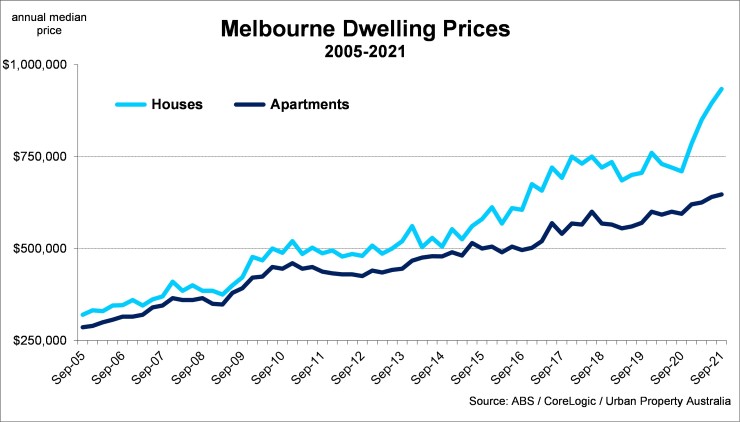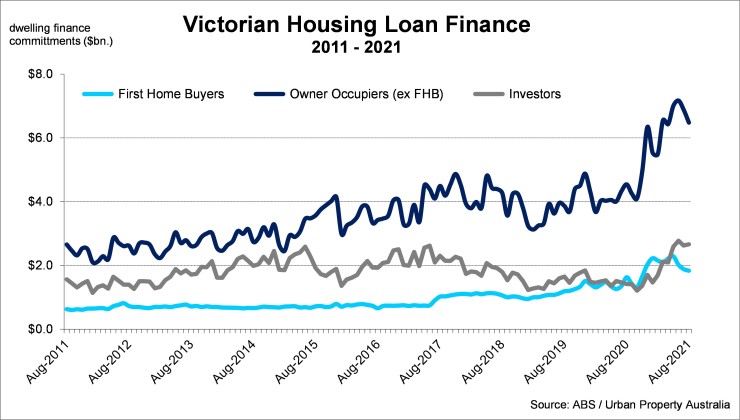Q3 2021 – Melbourne Residential Market
October 26th 2021 | , Urban Property Australia
- Melbourne’s house and apartment prices have once again set a new all-time high as at September 2021 with house prices growing at their fastest annual growth rate since 2009;
- Vacancy rate for Melbourne residential property appears to have peaked, falling to its lowest rate in a year, however, remains well above its 10-year average;
- Victorian housing owner occupier finance has surged in recent months to almost double the 10-year average with investor finance having increased by 88%.
Residential Market Summary
Despite the headwinds of various lockdowns and COVID-19 restrictions, Melbourne’s house and apartment prices have once again set a new all-time high as at September 2021. Melbourne house prices grew by 18% over the year to September 2021, its fastest annual growth rate since 2009. Victorian housing owner occupier finance has surged in recent months to almost double the 10-year average with investor finance increasing to 10-year highs.
Prices
Melbourne’s house and apartment prices have once again set a new all-time high as at September 2021. Melbourne house prices grew by 18% over the year to September 2021, its fastest annual growth rate since 2009. Although house prices have continued to grow, it is becoming increasingly clear the housing market moved past its peak rate of growth with prices rising by 4% over the September quarter compared to 10% quarterly growth over the December quarter. The slowing growth conditions likely reflect higher barriers to entry for non-homeowners along with fewer government incentives to enter the market. Melbourne apartment prices have also reached record high levels in September 2021, having increased by 6.8% over to year to $647,000. Despite the potential headwinds to price appreciation, monetary policy remains accommodative of high housing demand with persistently low advertised supply continuing to place upward pressure on housing values.

Supply
According to the ABS, there are currently 66,000 dwellings under construction across Victoria having trended down since 2018. Although the current dwelling supply pipeline of Victoria is below the peak of March 2018, the number of dwellings currently under construction remain 12% above the 10-year average. The closure of Australia’s international borders is also expected to reduce demand for inner city rental housing given the likely lack of international students in the short term. A shift in preferences towards detached houses has also been weighing on demand for inner city apartments. While population growth slumped in Victoria over the past year as residents moved to other states, risks of oversupply are mitigated by the considerably smaller volume of higher-density inner city apartments due for completion in 2021 relative to previous years. In the 12 months to August 2021, a total of 69,700 dwellings were approved in Victoria, its highest level in three years. Reflecting the slowdown of the development of apartment developments, approvals for houses now account for 70% of all new dwellings approved, compared to 53% as at August 2018.
Demand
Despite Victoria’s population declining by more than 42,000 over the past 12 months, current total Victorian housing finance commitments sit 68% above the 10-year average and reached all-time highs in June 2021 with $9 billion financed. The elevated housing finance levels have been underpinned by owner occupiers which have increased by 42% over the past 12 months. Although first home buyers remain active in the market with current levels at 89% above their 10-year average, levels appear to have peaked with levels trending down for the past four consecutive months. In contrast, investor finance continues to strengthen with levels increasing to 10-year highs as at August 2021. Over the past year, investor finance has increased by 88%, reaching $2.6 billion of commitments. Indeed, investors now account for 29% of total housing finance commitments in Victoria, compared to their share of 24% a year ago. Looking ahead, with the federal treasurer endorsing tighter credit policies for home lending, the volume of housing finance is likely to temper.

Vacancy
According to the REIV, as at September 2021, the vacancy rate for Melbourne residential property has fell to 5.0%, its lowest rate since November 2020, however, remains well above its 10-year average of 2.9%. Although vacancy rates of all precincts (with the exception of the Outer region) remain elevated, vacancy rates have trended down since peaking earlier this year. As at September 2021, the residential vacancy rate declined to 5.7% in the Inner (0-4km) precinct but increased to 7.1% in the Middle precinct and 2.1% in the Outer precinct. Looking ahead, Urban Property Australia projects that the vacancy rate for the metropolitan Melbourne area will remain above the long-term average for the short term, particularly in the Inner precincts given Victoria’s population growth will be muted for the medium term, constrained by the closure of Australia’s international borders affecting the international student market.
Rents
Emulating the vacancy trends, according to the REIV, metropolitan residential rents across most of the precincts are showing signs of recovering having fallen in through 2020. Over the year to September 2021, the weekly median rent for houses in metropolitan Melbourne rose to $495 per week, up from $470 per week a year earlier. Similarly, the weekly median rent for units has rose to $420 per week, up from $400 per week a year earlier. Looking forward, Urban Property expects that residential rents will gradually increase as the broader economy continues to improve following the shock of the pandemic, however increases will be constrained with Victoria’s population adversely impacted as a result of people leaving the state.
Copyright © 2021 by Urban Property Australia All rights reserved. No part of this publication may be reproduced in any form, by microfilm, xerography, electronically or otherwise, or incorporated into any information retrieval system, without the written permission of the copyright owner.



